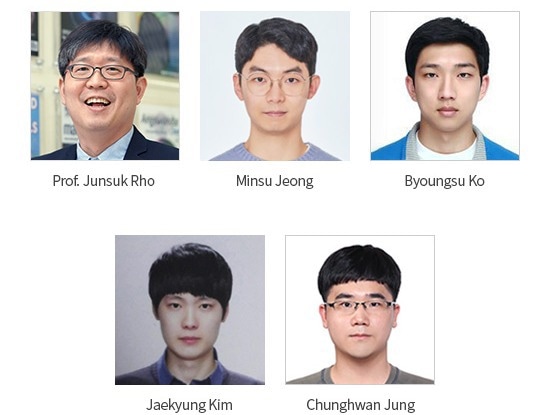Reviewed by Lexie CornerJun 12 2024
A team of researchers from Pohang University of Science and Technology used Nanoimprint Lithography (NIL) to create metasurfaces embedded with quantum dots, increasing luminescence efficiency. Their findings were published online in the international nanotechnology journal Nano Letters.
 Prof. Junsuk Rho and Ph.D. Candidates Minsu Jeong, Byoungsu Ko, Jaekyung Kim, and Chunghwan Jung. Image Credit: Pohang University of Science and Technology (POSTECH)
Prof. Junsuk Rho and Ph.D. Candidates Minsu Jeong, Byoungsu Ko, Jaekyung Kim, and Chunghwan Jung. Image Credit: Pohang University of Science and Technology (POSTECH)
NIL produces optical metasurfaces. This process rapidly transfers complex patterns at the nanometer (nm) scale using patterned stamps. It is more cost-effective than other processes like electron beam lithography and allows the creation of metasurfaces using materials that are unavailable in traditional processes.
The ability of metasurfaces to control the polarization and emission direction of light from quantum dots has drawn much attention lately. Nanoscale semiconductor particles called quantum dots are incredibly effective light emitters that can produce light at specific wavelengths. This feature makes them widely used in QLEDs and quantum computing applications. Nevertheless, conventional methods cannot embed quantum dots in metasurfaces. As a result, research has often involved fabricating metasurfaces and quantum dots separately and then combining them, which imposes limitations on controlling the luminescence of the quantum dots.
In the current study, researchers combined titanium dioxide (TiO2), a material used in the NIL process, with quantum dots to create a metasurface. This approach embeds the quantum dots directly within the metasurface during its creation, in contrast to conventional methods.
The resulting metasurface increases the number of photons emitted from the quantum dots that couple with the resonance mode. Compared to earlier techniques, this breakthrough enables more efficient control over the precise direction of light emitted from the quantum dots.
Experiments showed that luminescence efficiency increased with the number of photons released from the quantum dots coupled to the metasurface’s resonant modes. Compared with a basic quantum dot coating, the team’s metasurface produced up to 25 times higher luminescence efficiency.
The use of luminescence-controlled metasurfaces will enable sharper, brighter displays and more precise, sensitive biosensing. Further research will allow us to control luminescence more effectively, leading to advances in areas such as nano-optical sensors, optoelectronic devices, and quantum dot displays.
Junsuk Rho, Professor and Study Lead Researcher, Pohang University of Science and Technology
POSCO N.EX.T IMPACT, the Samsung Future Technology Incubation Program, the Ministry of Science and ICT's Mid-Career Researcher Program, and the National Research Foundation of Korea funded the study.
Journal Reference:
Jeong, M., et al. (2024) Printable Light-Emitting Metasurfaces with Enhanced Directional Photoluminescence. Nano Letters.doi.org/10.1021/acs.nanolett.4c00871